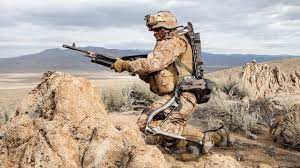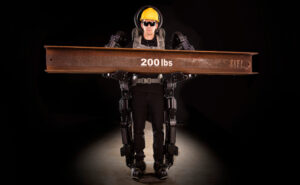Military Exoskeletons technology has emerged as a groundbreaking innovation with the potential to revolutionize various industries and sectors. These wearable robotic devices, inspired by the natural movements of the human body, offer immense benefits in terms of strength augmentation, enhanced endurance, and increased productivity.
While demand for exoskeletons have garnered significant attention in industrial applications, their impact in the military domain cannot be overlooked. Military exoskeletons have the potential to transform warfare by enhancing soldier capabilities, improving survivability, and revolutionizing combat strategies. In this article, we explore military exoskeletons, focusing on their design, functionality, and the ways in which they are reshaping the future of defense.
Key Market Opportunities Awaiting for Suppliers of Military Exoskeletons
The market for military exoskeletons presents significant opportunities for suppliers in the defense industry. Defense organizations worldwide are investing in soldier enhancement programs, making military exoskeletons a crucial component. Suppliers can collaborate with defense organizations to develop advanced exoskeleton systems tailored to specific military requirements.
Additionally, military exoskeletons have applications in combat support, logistics, rehabilitation, and injury prevention. Suppliers can tap into these areas by providing exoskeleton solutions that enhance efficiency, and effectiveness, and support rehabilitation efforts. The growing trend of international defense collaboration and the need for training and simulation programs further expand the market opportunities for suppliers of military exoskeletons.

Manufacturers of Military Exoskeletons include
BAE Systems
Lockheed Martin Corporation
General Atomics
Raytheon Company
Bionic Power Inc.
Safran
Ekso Bionics
SpringActive
Revision Military
SRI International
Key differences between Military & Industrial Exoskeletons
1. Design and Construction
Military exoskeletons are typically designed to withstand harsh environments and combat situations. They are built to be rugged, durable, and resistant to impact, debris, and extreme weather conditions. In contrast, industrial exoskeletons prioritize ergonomic design, comfort, and ease of use for workers in manufacturing or industrial settings.
2. Purpose and Functionality
Military exoskeletons are primarily developed to enhance the physical capabilities of soldiers in combat scenarios. They often focus on augmenting strength, agility, and endurance, allowing soldiers to carry heavier loads, traverse challenging terrains, and perform physically demanding tasks. Industrial exoskeletons, on the other hand, are designed to assist workers in performing repetitive or physically strenuous tasks in manufacturing or industrial environments, reducing fatigue and preventing musculoskeletal injuries.
3. Features and Technology
Demand for Military exoskeletons may incorporate advanced technologies such as advanced sensors, communication systems, and integrated weaponry. They may also include features like ballistic protection, camouflage, and night vision capabilities to enhance soldier survivability and combat effectiveness. Industrial exoskeletons, while technologically advanced in their own right, primarily focus on ergonomic support, load-bearing capabilities, and reducing physical strain on workers.
4. Operational Context
Military exoskeletons are used in combat or military operations, where soldiers face unpredictable and often hostile environments. They are designed to provide soldiers with enhanced mobility, protection, and combat effectiveness. Industrial exoskeletons, on the other hand, are used in controlled manufacturing or industrial settings, where the focus is on improving worker safety, productivity, and ergonomics.
5. Regulatory and Compliance Differences
Military exoskeletons may need to comply with specific military standards and regulations related to combat effectiveness, durability, and safety in combat zones. Industrial exoskeletons, on the other hand, may need to meet industry-specific regulations and standards related to worker safety, ergonomics, and occupational health.
Benefits of Industrial Exoskeletons
In the ever-evolving landscape of manufacturing, industries are constantly seeking innovative solutions to enhance efficiency, improve worker safety, and increase productivity. One such solution that has gained significant attention is the use of industrial exoskeletons. These wearable robotic devices offer numerous benefits, from reducing worker fatigue and injury risks to enhancing overall productivity.

Enhanced Worker Safety
Worker safety is a top priority for any manufacturing facility. Industrial exoskeletons provide additional support and protection to workers, reducing the risk of musculoskeletal injuries caused by repetitive tasks, heavy lifting, or awkward postures. By providing assistance to the wearer’s body movements, exoskeletons help maintain proper posture and reduce strain on the joints and muscles, minimizing the likelihood of work-related injuries.
Reduced Fatigue and Increased Productivity
The physical demands of certain manufacturing tasks can lead to worker fatigue, resulting in decreased productivity and potential errors. Industrial exoskeletons alleviate the strain on workers by providing mechanical support during physically demanding tasks. By reducing muscle fatigue and enabling workers to perform tasks with less effort, exoskeletons help improve overall productivity, allowing employees to maintain their performance levels for longer periods.
Ergonomic Benefits
Ergonomics is a critical aspect of any manufacturing operation. Industrial exoskeletons are designed with ergonomic principles in mind, ensuring that workers can perform tasks comfortably and efficiently. By promoting proper body mechanics and reducing the strain on the body, exoskeletons help prevent work-related musculoskeletal disorders and improve overall employee well-being.
Versatility and Adaptability
Industrial exoskeletons are available in various forms, catering to different manufacturing needs. From full-body exoskeletons for heavy lifting to upper-body or arm exoskeletons for repetitive tasks, these devices can be tailored to specific job requirements. Additionally, exoskeletons are adjustable and customizable, allowing workers to adapt them to their unique body shapes and preferences, further enhancing user comfort and usability.
Cost-Effectiveness
While industrial exoskeletons require an initial investment, they offer long-term cost savings. By reducing the risk of workplace injuries and associated medical costs, manufacturers can save on worker compensation claims and healthcare expenses. Moreover, the increased productivity and efficiency resulting from the use of exoskeletons can lead to higher output and profitability for manufacturing operations.
Conclusion
While there may be certain similarities in terms of technology and design principles, military and industrial exoskeletons have distinct purposes and functionalities. Military exoskeletons are tailored for combat scenarios, emphasizing strength, endurance, and survivability, while industrial exoskeletons prioritize worker safety, ergonomics, and productivity in manufacturing or industrial settings.
Also Read:




